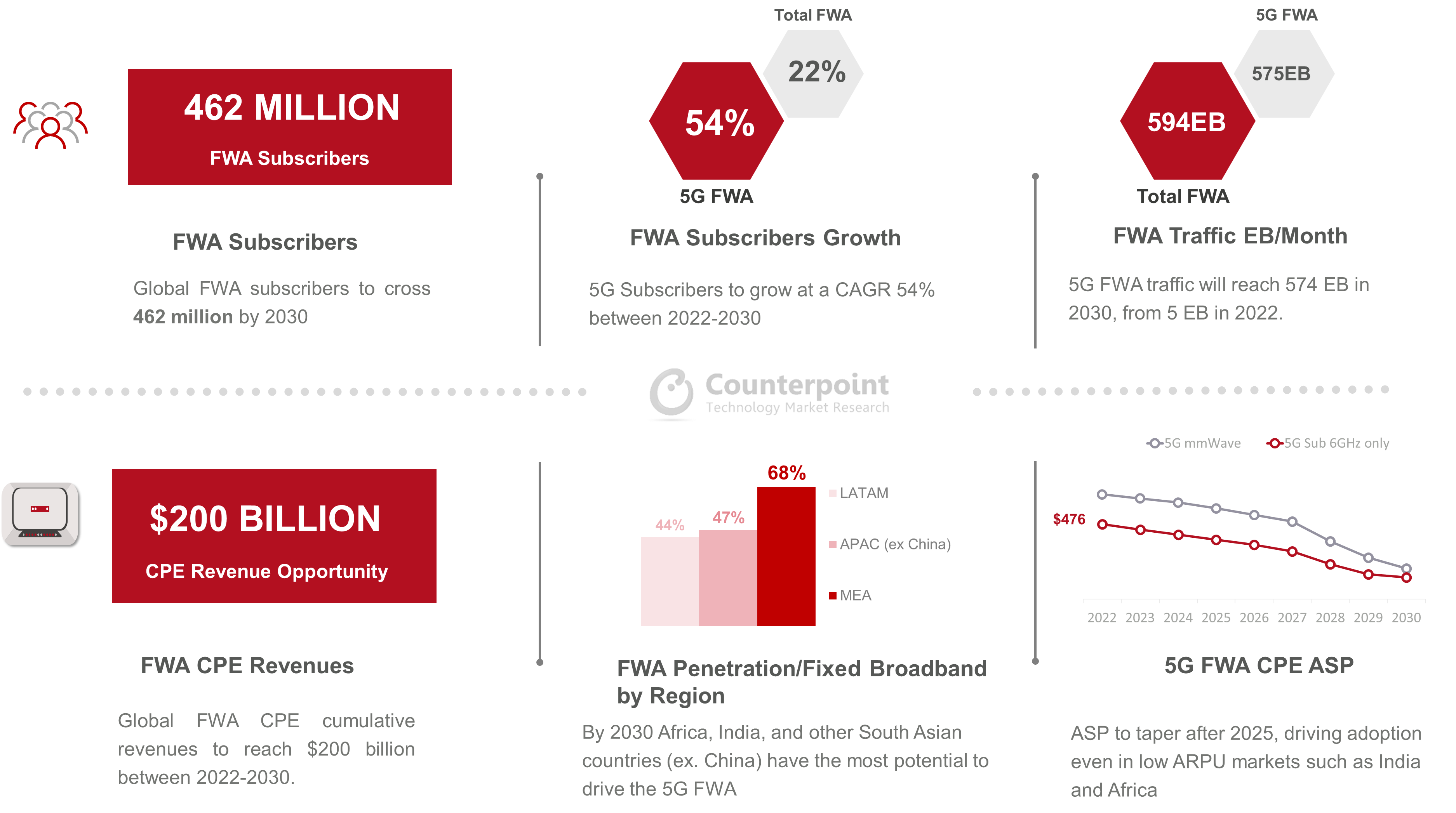Trends
FWA to exceed 460 million subscriptions by 2030
As 5G takes center stage, the new 5G network architectures and broader spectrum promises enhanced broadband services at a scale not possible in previous generations. Many developing economies as well as parts of developed economies still suffer from a digital divide with many unable to access broadband connectivity. We believe 5G-enabled Fixed Wireless Access (FWA) is a killer use-case for bridging this digital divide and providing connectivity where fiber or even DSL has not yet reached. We estimate the total FWA broadband subscriptions to climb to around 462 million by 2030 from roughly 75 million in 2021. 5G FWA will drive the bulk of the growth beyond 2025 replacing 4G FWA connections that will be still prevalent in some markets across MEA, developing Asia and Latin America until 2024.
Commenting on the market dynamics, Principal Analyst Tina Lu said “By the end of 2021, only one out of every three households around the world (excluding China) had access to fixed broadband. And only 25% of those households enjoyed speeds greater than 100 Mbps. With the growing work-from-home and hybrid working and learning trends, a stable, fast and high-capacity connection has become imperative.
“In light of that, we are seeing a significant push from operators and even governments to prioritize national broadband initiatives with 5G FWA becoming integral to their 5G rollout strategies. For example, the launch of T-Mobile 5G Home Internet service in the US to provide high-speed broadband across USA trying to bridge gaps and challenge cable monopolies. Similarly, Optus in Australia has been aggressively rolling out FWA services since the beginning of 2021. Furthermore, several MNOs across Europe and the Middle East, are seeing rising adoption for 5G FWA”.
Speaking about the 5G FWA momentum and outlook, Ms Lu added, “The US is currently the single biggest 5G FWA market, with both Verizon and T-Mobile being bullish on 5G FWA with mmWave rollouts ideal for dense urban connectivity, and sub-6GHz spectrum driving broader coverage and above average throughput speeds. European operators, especially in UK and Spain are still pushing to increase fiber broadband infrastructure, thus delaying the rollout of 5G FWA networks. But the last-mile connection to fiber is very costly in rural areas, which opens the need for 5G FWA. Africa, India, and other South Asian countries (excluding China), on the other hand, have the lowest fiber penetration and thus have the most potential to drive the 5G FWA subscriber growth this decade. Latin America will also see 5G FWA services launch in the next few years to drive home broadband penetration.”

Commenting on the demand and supply across the ecosystem, Senior Research Analyst Parv Sharma said, “It has been a double-edged sword the last couple of years for 5G FWA adoption. While the pandemic accelerated the demand for broadband connectivity, but it also put serious pressure on MNOs CAPEX budgets slowing down 5G rollouts. The supply chain issues exacerbated the situation as the average 5G CPE prices remained in the US$500-$700 range, well-above mass market levels.
Further, the US is currently driving both sub-6GHz and 5G mmWave FWA services together with Australia, Italy, and a few Middle Eastern operators. As a result, the initial 5G CPEs ASPs have been higher.
However, the supply chain issues are expected to moderate in the second half of 2022. Further, 5G CPE prices should hit mainstream levels by mid-2023 and mass market levels by the end of 2024 supported by a growing ecosystem of CPE vendors’ from Arcadyan, Casa Systems, Askey, Inseego, Nokia, Ericsson, TCL, Wistron, ZTE and other emerging Chinese vendors, all supported by chipset solutions from Qualcomm, MediaTek and UNISOC. With greater scale and the maturation of the 5G technologies, we expect the ASP to taper quickly after 2025, driving adoption even in low ARPU markets such as India and Africa which face a significant digital divide.
CT Bureau















You must be logged in to post a comment Login